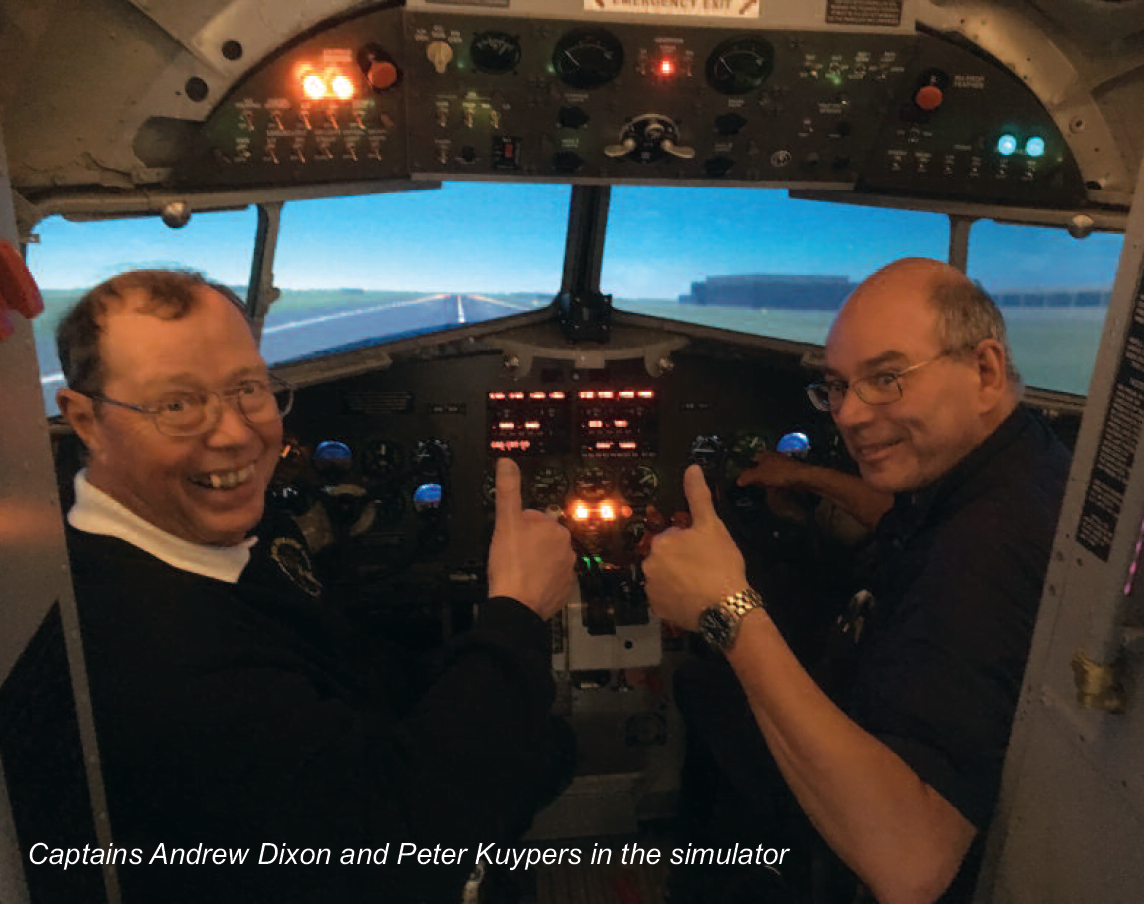By Captain Peter Kuypers
When training on Sally B, there is a limit to what we can train to protect our four massive radial engines.
When flying with KLM I learned so much from training on a simulator and thought this could really work for us as well.
But there is no B-17 simulator anywhere, but luckily, there is one for Dc-3’s in the Netherlands.
Whereas the Dc-3 is only a two engined aircraft the similarities of operation are so very close.
With this in mind Andrew Dixon and I visited a simulator company in the Netherlands who operate a Dc-3 simulator and came back pleasantly surprised.
We have now begun to implement a modern training regime which will benefit all our pilots. We will still keep training on the aircraft as we have always done, this simulator is an extra which should give us more exposure to emergencies and make the pilots more proficient.
The company is “Multi Pilot Simulations” (www.mps.aero) who in daily life manufacture Airbus and Boeing simulators for the likes of Ryanair, Cathay etc.
Some time ago they manufactured a DC-3 simulator and Andrew and I got to fly it. I have to emphasize that this is a professional training tool and not a toy.
Although the DC-3 is a different aircraft it is still very similar in operation to the B-17 and can be used to train emergency procedures which are impossible to train on the aircraft.
The DC-3 weighs 26,000 lbs and has two radial engines each delivering 1200hp, the B-17 weighs 50.000lbs and has four 1200hp engines, the speeds are similar.
Someone asked me what it would be like to have two B-17 engines failing on the same side: well it is a bit like having one engine go on a DC-3.
With pilots who were not familiar on the DC-3 we even used Sally B checklists and procedures, more about this later.
We began the training with Andrew flying, myself as co-pilot plus another pilot manning the instructor station.
Soon after take-off in a heavy aircraft the left engine blew up and we had to work as a team to get it secured, the propeller feathered and very, very slowly climb away.
We looked at several types of propeller and propeller feathering failures and even engine fires.
When in the simulator (but also in a real emergency) you can get so busy that the brain gets overloaded making it difficult to recognize situations and to remember procedures.
Repeated training will help to cope with this.
I had an engine failure where I feathered the propeller but a short time later the prop came out of feather and I could not secure the engine which resulted in a shallow descent. I could not figure out what was happening, just pausing the simulator gave me some rest to find the solution which if it ever happens to me in real life should not be a problem.
Next was display flying combined with engine failures, this is not something you would like to do in the real aircraft as it is inherently dangerous due to the close proximity of the ground.
During this part we were surprised to see that if an engine failure was simulated during a shallow descent it was difficult to even notice that the engine is no longer producing power, the engine instruments do not give you a clue here. It is only later when trying to climb away from low altitude that life gets interesting.
Even CAA guidance about this does not tell the real story.
I know that this all sounds very exciting and even dangerous but that is what the training is for so we can cope in real life!
New Pilot Paul Szluha was next
My next session was with our new co-pilot Paul Szluha. Paul’s background is as an engineer and airline captain and before that, he was part of the engineering team on Sally B.
We decided to operate as if it was a B-17 using the Sally B procedures and checklist, this worked amazingly well.
We started with normal take-offs and landings with light winds and soon it was time to give Paul some crosswind landings followed by the dreaded engine failure just after take-off. We simulated many failures when suddenly we had an engine fire.
I was the flying pilot and Paul was doing the co-pilots duties when suddenly the fuel pressure dropped followed shortly by a red light on the instrument panel. This red light was the fire warning light due to a fuel leak causing an engine fire;
Paul did the emergency checklist and got the engine secured and the fire extinguished.
After more than 3 hours training it was time to go home, Paul you did a good job!
Elly has decided that we will keep using this simulator because the training value is essential to increases the safety of our flight training. I just hope that we will not have to put what we have learned into practice but if we have to, we are ready.
Editor’s Note: We met the Sally B team at a B-17 event in France in 2015.
We are partnered with them and urge our readers to support the Sally B in any they can.
This article is taken from Sally B News, Issue 57, Winter/Spring 2019/20
Sally B News issue 57

